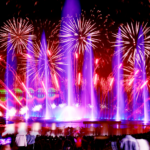Daming Temple is located on the Shugang Zhongfeng in the northwest corner of Slender West Lake in Yangzhou, named after its initial construction during the reign of Emperor Xiaowu of the Southern Song Dynasty (457-464 AD). The temple complex visible today was built during the Tongzhi period of the Qing Dynasty. The temple gained fame as the place where the eminent monk Jianzhen, before his eastward journey to Japan, preached and imparted precepts.
Daming Temple is divided into three sections: the central part is the main temple architecture, the eastern part is the Qiling Pagoda, and the western part is the garden-style backyard known as Xiyuan. Visitors can tour the entire temple by following the central-eastern-western sequence.

Ascending the gentle steps up the hill, which is only 28 meters above sea level, one arrives at the main entrance of Daming Temple. On both sides of the mountain path, there are many vendors selling incense; however, these should not be purchased as outside incense is not allowed inside the temple. Incense can be purchased within the temple for a starting price of 60 yuan, which is relatively expensive, and one may opt to simply pay respects without burning incense.

The main temple architecture in the central part of the scenic area is divided into three routes along the north-south axis. From south to north on the central axis are the archway, the mountain gate that also serves as the Hall of Heavenly Kings, and the Mahavira Hall. On the west route, the main attraction is Ouyang Xiu, with the Ping Shan Hall built by him during his tenure as the prefect of Yangzhou, followed by the Gu Lin Hall, built by Su Dongpo in memory of Ouyang Xiu behind the Ping Shan Hall, and the Ouyang Ancestral Hall to the north.

The Qiling Pagoda in the eastern part of the scenic area was originally built by Emperor Yang Jian of the Sui Dynasty to celebrate his birthday. The tower visible today is a reconstruction based on the Sui Dynasty’s original tower. The tower is nine stories high and houses relics and a sandalwood pagoda. Climbing to the top of the tower offers a panoramic view of the entire Daming Temple, as well as a distant view of Slender West Lake and the city of Yangzhou. To the east and west sides of the Qiling Pagoda are the bell tower and drum tower, respectively, and the reclining Buddha hall to the north displays a jade Buddha from Myanmar.
There is an imperial stele pavilion of Emperor Qianlong on the east side of the lake, with three imperial steles of Emperor Qianlong. In the lake, there is the Fifth Spring Under Heaven. This ‘fifth’ was evaluated by Zhang Youxin, the author of ‘Notes on Boiling Tea Water’ in the Tang Dynasty. Walking a little south from the imperial stele of Emperor Qianlong, one can see the stone stele of ‘the Fifth Spring’ and an ancient well. On December 31 every year, Daming Temple has a lively ‘New Year Bell-striking Ceremony’. The activity lasts across the year. Citizens in the temple, accompanied by the 108 tolls of the bell ringing at midnight, pray for peace and good fortune in the new year. On the birthdays and commemorative days of various Bodhisattvas, Daming Temple also holds Dharma assemblies. In the northeast corner of the temple, on the east side of the Jianzhen Memorial Hall, there is Baiweizhai Vegetarian Restaurant. The dishes are diverse and exquisite. If ordering à la carte, the per capita cost is 100 yuan. It’s a bit expensive but tastes very good. Opening hours: Open all year round from 08:00 to 17:00. Preferential policies: Children: Children under 6 years old (inclusive) or children with a height of 1.4 meters (inclusive) or below can enter for free with valid certificates. Minors: Children aged 6 (excluding) to 18 years old (inclusive) enjoy half-price. Elderly: Elderly people aged 70 years old (inclusive) or above can enter for free with valid identity documents. Elderly people aged 60 years old (inclusive) to 69 years old (inclusive) can enter for half-price with their ID cards (senior citizen cards). Military personnel: Free admission with active military officer certificates and disabled military personnel certificates. Retired cadres: Free admission with ‘Honorary Certificate for Retired Cadres’, ‘Privilege Certificate for Veteran Cadres’, and for military retirees. Journalists: Free admission with ‘Press Card’ issued by the State Press and Publication Administration. Students: Full-time undergraduate and below students can enter for half-price. Special honorary groups: Free admission with ‘Moral Model Certificate’, ‘Model Worker Certificate’ at or above the municipal-ministerial level, and ‘Hero Model Certificate’. Disabled people: Free admission with disability certificates. Yangzhou preferential treatment: Free admission with ‘Yangzhou Park Preferential Treatment Certificate’, ‘Yangzhou Military Wife Certificate’, and ‘Yangzhou Tourist Attraction Annual Card’. Service facilities: Parking lot: [Yangzhou Daming Temple Parking Lot]. Reference price: ¥5/hour. Address: No. 8 Pingshantang Road, Yangzhou City. Number of parking spaces: 50.









